Abstract
Determinants of the recommended dietary allowance (RDA) for vitamin C include the relationship between vitamin C dose and steady-state plasma concentration, bioavailability, urinary excretion, cell concentration, and potential adverse effects. Because current data are inadequate, an in-hospital depletion-repletion study was conducted. Seven healthy volunteers were hospitalized for 4-6 months and consumed a diet containing <5 mg of vitamin C daily. Steady-state plasma and tissue concentrations were determined at seven daily doses of vitamin C from 30 to 2500 mg. Vitamin C steady-state plasma concentrations as a function of dose displayed sigmoid kinetics. The steep portion of the curve occurred between the 30- and 100-mg daily dose, the current RDA of 60 mg daily was on the lower third of the curve, the first dose beyond the sigmoid portion of the curve was 200 mg daily, and complete plasma saturation occurred at 1000 mg daily. Neutrophils, monocytes, and lymphocytes saturated at 100 mg daily and contained concentrations at least 14-fold higher than plasma. Bioavailability was complete for 200 mg of vitamin C as a single dose. No vitamin C was excreted in urine of six of seven volunteers until the 100-mg dose. At single doses of 500 mg and higher, bioavailability declined and the absorbed amount was excreted. Oxalate and urate excretion were elevated at 1000 mg of vitamin C daily compared to lower doses. Based on these data and Institute of Medicine criteria, the current RDA of 60 mg daily should be increased to 200 mg daily, which can be obtained from fruits and vegetables. Safe doses of vitamin C are less than 1000 mg daily, and vitamin C daily doses above 400 mg have no evident value.
Full text
PDF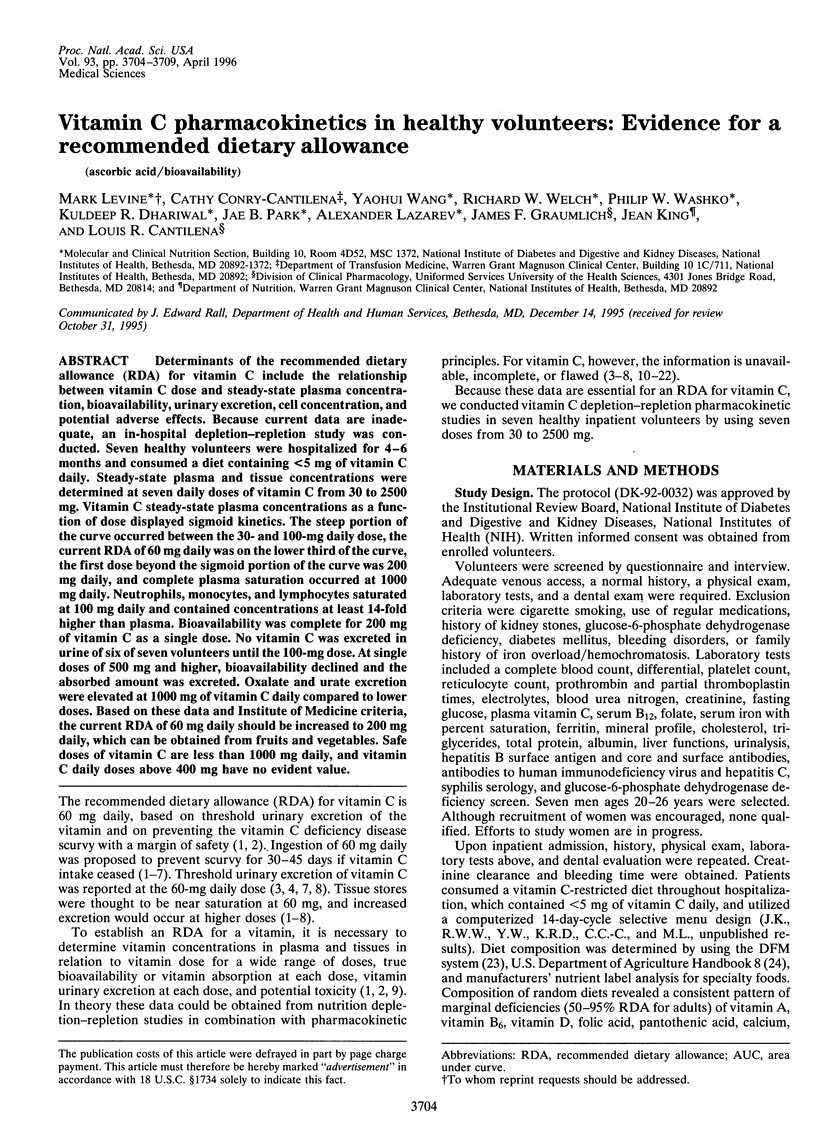
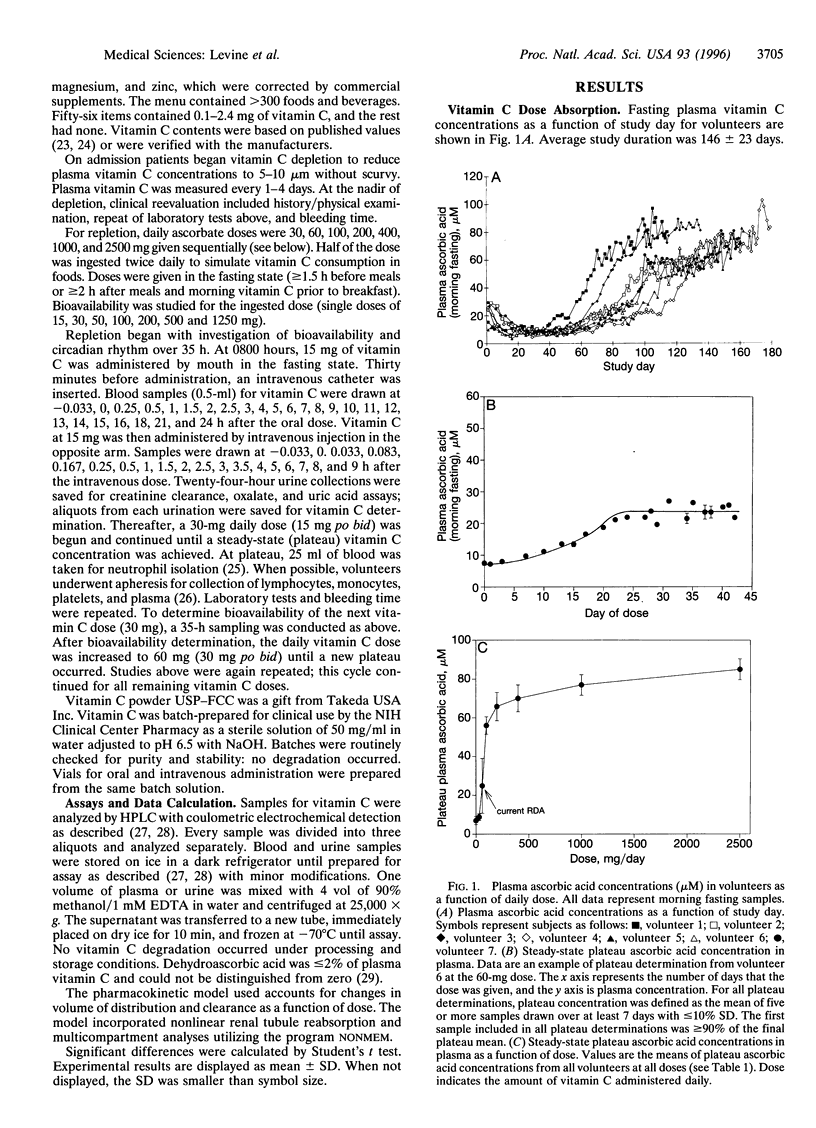

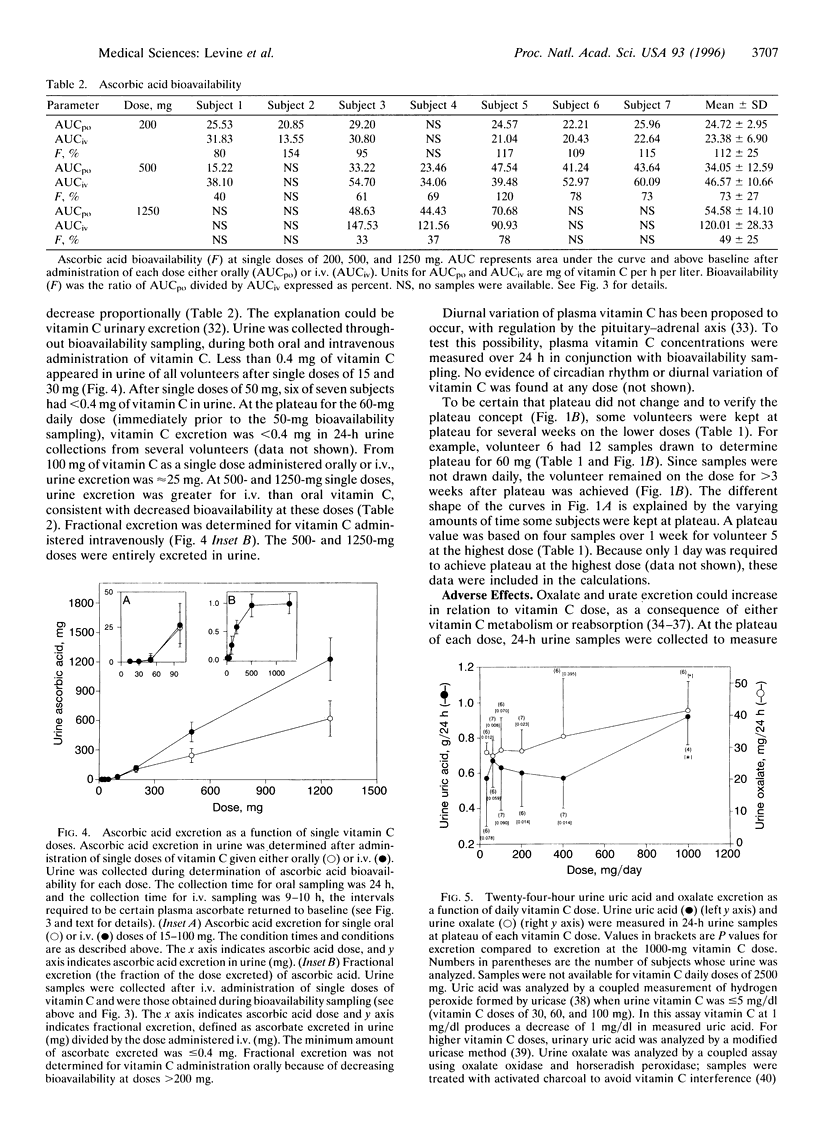
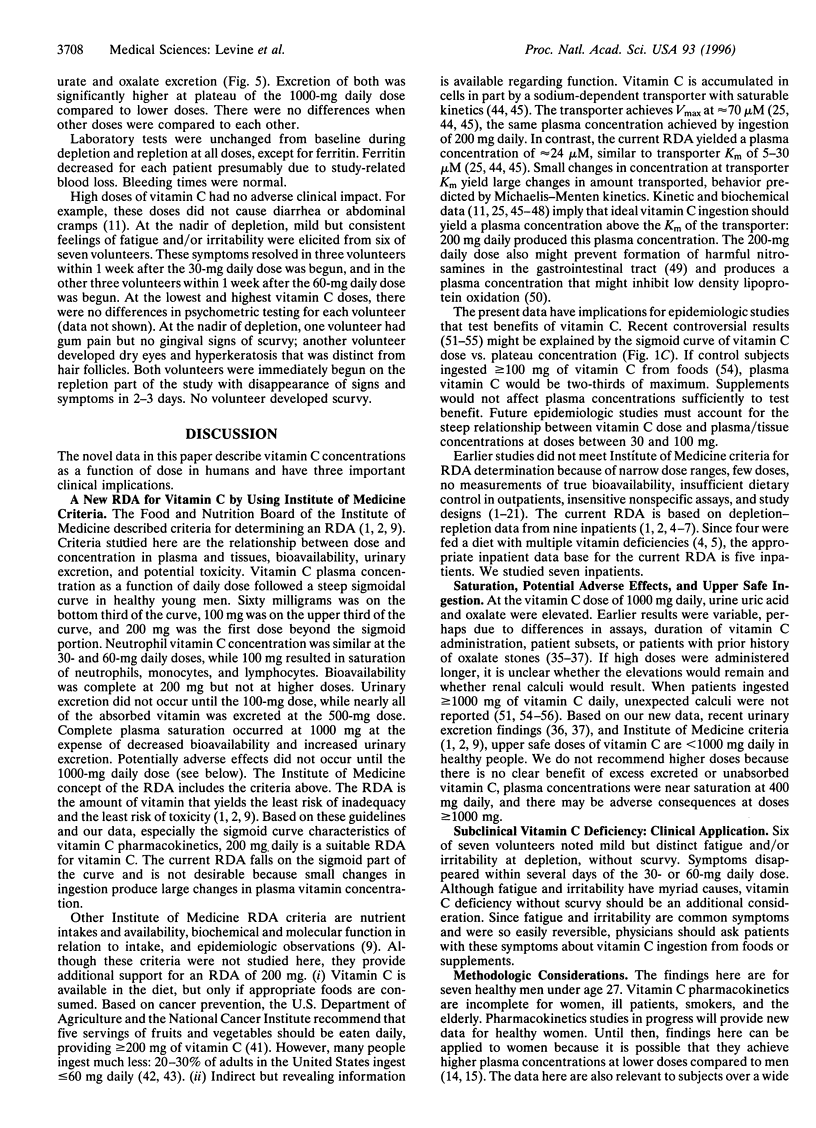
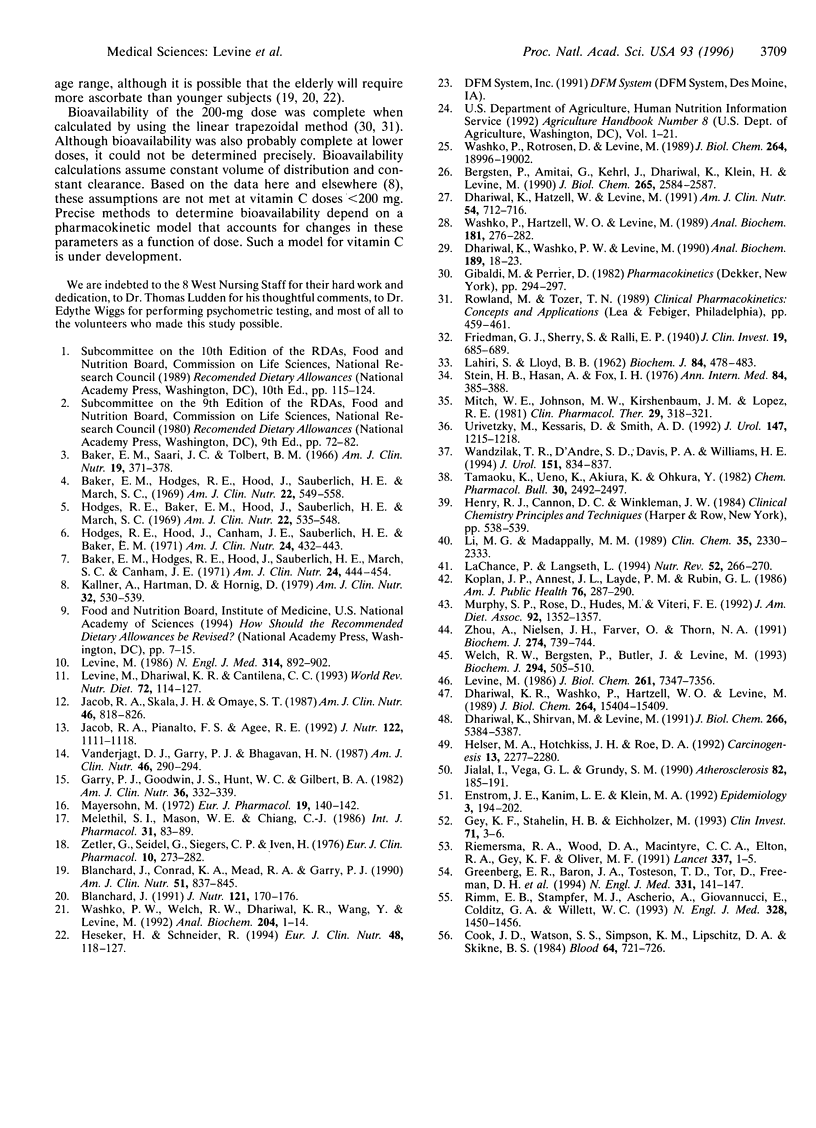
Selected References
These references are in PubMed. This may not be the complete list of references from this article.
- Baker E. M., Hodges R. E., Hood J., Sauberlich H. E., March S. C., Canham J. E. Metabolism of 14C- and 3H-labeled L-ascorbic acid in human scurvy. Am J Clin Nutr. 1971 Apr;24(4):444–454. doi: 10.1093/ajcn/24.4.444. [DOI] [PubMed] [Google Scholar]
- Baker E. M., Hodges R. E., Hood J., Sauberlich H. E., March S. C. Metabolism of ascorbic-1-14C acid in experimental human scurvy. Am J Clin Nutr. 1969 May;22(5):549–558. doi: 10.1093/ajcn/22.5.549. [DOI] [PubMed] [Google Scholar]
- Baker E. M., Saari J. C., Tolbert B. M. Ascorbic acid metabolism in man. Am J Clin Nutr. 1966 Dec;19(6):371–378. doi: 10.1093/ajcn/19.5.371. [DOI] [PubMed] [Google Scholar]
- Bergsten P., Amitai G., Kehrl J., Dhariwal K. R., Klein H. G., Levine M. Millimolar concentrations of ascorbic acid in purified human mononuclear leukocytes. Depletion and reaccumulation. J Biol Chem. 1990 Feb 15;265(5):2584–2587. [PubMed] [Google Scholar]
- Blanchard J., Conrad K. A., Mead R. A., Garry P. J. Vitamin C disposition in young and elderly men. Am J Clin Nutr. 1990 May;51(5):837–845. doi: 10.1093/ajcn/51.5.837. [DOI] [PubMed] [Google Scholar]
- Blanchard J. Depletion and repletion kinetics of vitamin C in humans. J Nutr. 1991 Feb;121(2):170–176. doi: 10.1093/jn/121.2.170. [DOI] [PubMed] [Google Scholar]
- Cook J. D., Watson S. S., Simpson K. M., Lipschitz D. A., Skikne B. S. The effect of high ascorbic acid supplementation on body iron stores. Blood. 1984 Sep;64(3):721–726. [PubMed] [Google Scholar]
- Dhariwal K. R., Hartzell W. O., Levine M. Ascorbic acid and dehydroascorbic acid measurements in human plasma and serum. Am J Clin Nutr. 1991 Oct;54(4):712–716. doi: 10.1093/ajcn/54.4.712. [DOI] [PubMed] [Google Scholar]
- Dhariwal K. R., Shirvan M., Levine M. Ascorbic acid regeneration in chromaffin granules. In situ kinetics. J Biol Chem. 1991 Mar 25;266(9):5384–5387. [PubMed] [Google Scholar]
- Dhariwal K. R., Washko P. W., Levine M. Determination of dehydroascorbic acid using high-performance liquid chromatography with coulometric electrochemical detection. Anal Biochem. 1990 Aug 15;189(1):18–23. doi: 10.1016/0003-2697(90)90037-a. [DOI] [PubMed] [Google Scholar]
- Dhariwal K. R., Washko P., Hartzell W. O., Levine M. Ascorbic acid within chromaffin granules. In situ kinetics of norepinephrine biosynthesis. J Biol Chem. 1989 Sep 15;264(26):15404–15409. [PubMed] [Google Scholar]
- Enstrom J. E., Kanim L. E., Klein M. A. Vitamin C intake and mortality among a sample of the United States population. Epidemiology. 1992 May;3(3):194–202. doi: 10.1097/00001648-199205000-00003. [DOI] [PubMed] [Google Scholar]
- Friedman G. J., Sherry S., Ralli E. P. THE MECHANISM OF THE EXCRETION OF VITAMIN C BY THE HUMAN KIDNEY AT LOW AND NORMAL PLASMA LEVELS OF ASCORBIC ACID. J Clin Invest. 1940 Sep;19(5):685–689. doi: 10.1172/JCI101171. [DOI] [PMC free article] [PubMed] [Google Scholar]
- Garry P. J., Goodwin J. S., Hunt W. C., Gilbert B. A. Nutritional status in a healthy elderly population: vitamin C. Am J Clin Nutr. 1982 Aug;36(2):332–339. doi: 10.1093/ajcn/36.2.332. [DOI] [PubMed] [Google Scholar]
- Gey K. F., Stähelin H. B., Eichholzer M. Poor plasma status of carotene and vitamin C is associated with higher mortality from ischemic heart disease and stroke: Basel Prospective Study. Clin Investig. 1993 Jan;71(1):3–6. doi: 10.1007/BF00210955. [DOI] [PubMed] [Google Scholar]
- Greenberg E. R., Baron J. A., Tosteson T. D., Freeman D. H., Jr, Beck G. J., Bond J. H., Colacchio T. A., Coller J. A., Frankl H. D., Haile R. W. A clinical trial of antioxidant vitamins to prevent colorectal adenoma. Polyp Prevention Study Group. N Engl J Med. 1994 Jul 21;331(3):141–147. doi: 10.1056/NEJM199407213310301. [DOI] [PubMed] [Google Scholar]
- Helser M. A., Hotchkiss J. H., Roe D. A. Influence of fruit and vegetable juices on the endogenous formation of N-nitrosoproline and N-nitrosothiazolidine-4-carboxylic acid in humans on controlled diets. Carcinogenesis. 1992 Dec;13(12):2277–2280. doi: 10.1093/carcin/13.12.2277. [DOI] [PubMed] [Google Scholar]
- Heseker H., Schneider R. Requirement and supply of vitamin C, E and beta-carotene for elderly men and women. Eur J Clin Nutr. 1994 Feb;48(2):118–127. [PubMed] [Google Scholar]
- Hodges R. E., Baker E. M., Hood J., Sauberlich H. E., March S. C. Experimental scurvy in man. Am J Clin Nutr. 1969 May;22(5):535–548. doi: 10.1093/ajcn/22.5.535. [DOI] [PubMed] [Google Scholar]
- Hodges R. E., Hood J., Canham J. E., Sauberlich H. E., Baker E. M. Clinical manifestations of ascorbic acid deficiency in man. Am J Clin Nutr. 1971 Apr;24(4):432–443. doi: 10.1093/ajcn/24.4.432. [DOI] [PubMed] [Google Scholar]
- Jacob R. A., Pianalto F. S., Agee R. E. Cellular ascorbate depletion in healthy men. J Nutr. 1992 May;122(5):1111–1118. doi: 10.1093/jn/122.5.1111. [DOI] [PubMed] [Google Scholar]
- Jacob R. A., Skala J. H., Omaye S. T. Biochemical indices of human vitamin C status. Am J Clin Nutr. 1987 Nov;46(5):818–826. doi: 10.1093/ajcn/46.5.818. [DOI] [PubMed] [Google Scholar]
- Jialal I., Vega G. L., Grundy S. M. Physiologic levels of ascorbate inhibit the oxidative modification of low density lipoprotein. Atherosclerosis. 1990 Jun;82(3):185–191. doi: 10.1016/0021-9150(90)90039-l. [DOI] [PubMed] [Google Scholar]
- Kallner A., Hartmann D., Hornig D. Steady-state turnover and body pool of ascorbic acid in man. Am J Clin Nutr. 1979 Mar;32(3):530–539. doi: 10.1093/ajcn/32.3.530. [DOI] [PubMed] [Google Scholar]
- Koplan J. P., Annest J. L., Layde P. M., Rubin G. L. Nutrient intake and supplementation in the United States (NHANES II). Am J Public Health. 1986 Mar;76(3):287–289. doi: 10.2105/ajph.76.3.287. [DOI] [PMC free article] [PubMed] [Google Scholar]
- LAHIRI S., LLOYD B. B. The effect of stress and corticotrophin on the concentrations of vitamin C in blood and tissues of the rat. Biochem J. 1962 Sep;84:478–483. doi: 10.1042/bj0840478. [DOI] [PMC free article] [PubMed] [Google Scholar]
- Lachance P., Langseth L. The RDA concept: time for a change? Nutr Rev. 1994 Aug;52(8 Pt 1):266–270. doi: 10.1111/j.1753-4887.1994.tb01454.x. [DOI] [PubMed] [Google Scholar]
- Levine M. Ascorbic acid specifically enhances dopamine beta-monooxygenase activity in resting and stimulated chromaffin cells. J Biol Chem. 1986 Jun 5;261(16):7347–7356. [PubMed] [Google Scholar]
- Levine M., Cantilena C. C., Dhariwal K. R. In situ kinetics and ascorbic acid requirements. World Rev Nutr Diet. 1993;72:114–127. doi: 10.1159/000422333. [DOI] [PubMed] [Google Scholar]
- Levine M. New concepts in the biology and biochemistry of ascorbic acid. N Engl J Med. 1986 Apr 3;314(14):892–902. doi: 10.1056/NEJM198604033141407. [DOI] [PubMed] [Google Scholar]
- Li M. G., Madappally M. M. Rapid enzymatic determination of urinary oxalate. Clin Chem. 1989 Dec;35(12):2330–2333. [PubMed] [Google Scholar]
- Mayersohn M. Ascorbic acid absorption in man--pharmacokinetic implications. Eur J Pharmacol. 1972 Jul;19(1):140–142. doi: 10.1016/0014-2999(72)90092-1. [DOI] [PubMed] [Google Scholar]
- Mitch W. E., Johnson M. W., Kirshenbaum J. M., Lopez R. E. Effect of large oral doses of ascorbic acid on uric acid excretion by normal subjects. Clin Pharmacol Ther. 1981 Mar;29(3):318–321. doi: 10.1038/clpt.1981.42. [DOI] [PubMed] [Google Scholar]
- Murphy S. P., Rose D., Hudes M., Viteri F. E. Demographic and economic factors associated with dietary quality for adults in the 1987-88 Nationwide Food Consumption Survey. J Am Diet Assoc. 1992 Nov;92(11):1352–1357. [PubMed] [Google Scholar]
- Riemersma R. A., Wood D. A., Macintyre C. C., Elton R. A., Gey K. F., Oliver M. F. Risk of angina pectoris and plasma concentrations of vitamins A, C, and E and carotene. Lancet. 1991 Jan 5;337(8732):1–5. doi: 10.1016/0140-6736(91)93327-6. [DOI] [PubMed] [Google Scholar]
- Rimm E. B., Stampfer M. J., Ascherio A., Giovannucci E., Colditz G. A., Willett W. C. Vitamin E consumption and the risk of coronary heart disease in men. N Engl J Med. 1993 May 20;328(20):1450–1456. doi: 10.1056/NEJM199305203282004. [DOI] [PubMed] [Google Scholar]
- Stein H. B., Hasan A., Fox I. H. Ascorbic acid-induced uricosuria. A consequency of megavitamin therapy. Ann Intern Med. 1976 Apr;84(4):385–388. doi: 10.7326/0003-4819-84-4-385. [DOI] [PubMed] [Google Scholar]
- Urivetzky M., Kessaris D., Smith A. D. Ascorbic acid overdosing: a risk factor for calcium oxalate nephrolithiasis. J Urol. 1992 May;147(5):1215–1218. doi: 10.1016/s0022-5347(17)37521-3. [DOI] [PubMed] [Google Scholar]
- VanderJagt D. J., Garry P. J., Bhagavan H. N. Ascorbic acid intake and plasma levels in healthy elderly people. Am J Clin Nutr. 1987 Aug;46(2):290–294. doi: 10.1093/ajcn/46.2.290. [DOI] [PubMed] [Google Scholar]
- Wandzilak T. R., D'Andre S. D., Davis P. A., Williams H. E. Effect of high dose vitamin C on urinary oxalate levels. J Urol. 1994 Apr;151(4):834–837. doi: 10.1016/s0022-5347(17)35100-5. [DOI] [PubMed] [Google Scholar]
- Washko P. W., Hartzell W. O., Levine M. Ascorbic acid analysis using high-performance liquid chromatography with coulometric electrochemical detection. Anal Biochem. 1989 Sep;181(2):276–282. doi: 10.1016/0003-2697(89)90243-1. [DOI] [PubMed] [Google Scholar]
- Washko P. W., Welch R. W., Dhariwal K. R., Wang Y., Levine M. Ascorbic acid and dehydroascorbic acid analyses in biological samples. Anal Biochem. 1992 Jul;204(1):1–14. doi: 10.1016/0003-2697(92)90131-p. [DOI] [PubMed] [Google Scholar]
- Washko P., Rotrosen D., Levine M. Ascorbic acid transport and accumulation in human neutrophils. J Biol Chem. 1989 Nov 15;264(32):18996–19002. [PubMed] [Google Scholar]
- Welch R. W., Bergsten P., Butler J. D., Levine M. Ascorbic acid accumulation and transport in human fibroblasts. Biochem J. 1993 Sep 1;294(Pt 2):505–510. doi: 10.1042/bj2940505. [DOI] [PMC free article] [PubMed] [Google Scholar]
- Zhou A., Nielsen J. H., Farver O., Thorn N. A. Transport of ascorbic acid and dehydroascorbic acid by pancreatic islet cells from neonatal rats. Biochem J. 1991 Mar 15;274(Pt 3):739–744. doi: 10.1042/bj2740739. [DOI] [PMC free article] [PubMed] [Google Scholar]


